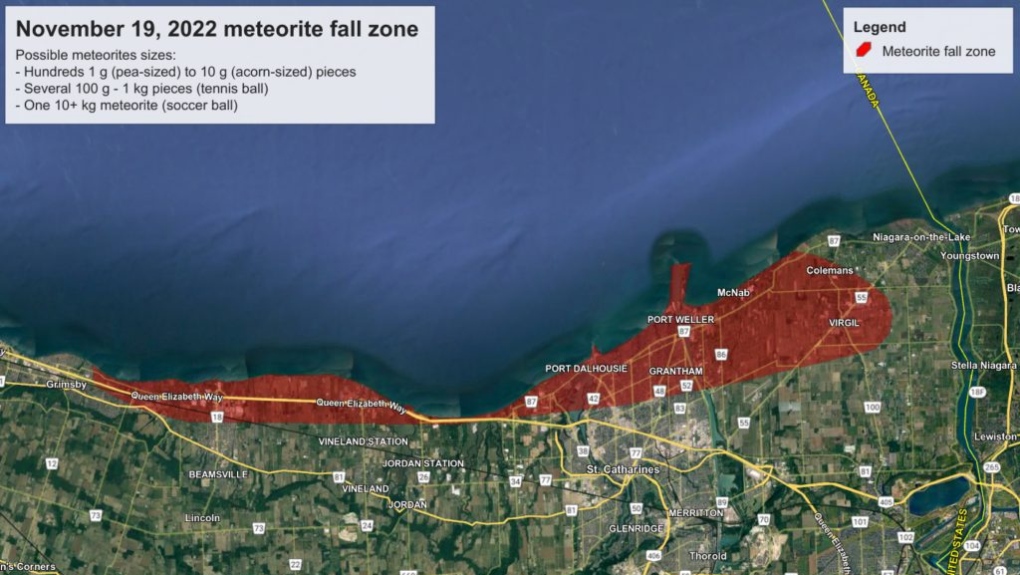Bright fireball lights up Ontario sky, may have dropped meteorites in Niagara: Western University
In a truly out of this world sight, a small asteroid hurtling towards Earth was tracked by scientists for three hours where its trajectory brought it over the skies of southern Ontario over the weekend, according to London, Ont.’s Western University.
According to a press release from Western University, just before midnight on Nov. 18, the Catalina Sky Survey in Arizona detected a small celestial object heading towards Earth.
A small asteroid, now named 2022 WJ1, was tracked by multiple observatories around the world for three hours as the object travelled towards Earth and traversed across the sky over southern Ontario, where it made impact over at 3:26 a.m. on Nov. 19.
The advance warning of the asteroid gave researchers of the Western Meteor Physics Group and the Institute for Earth and Space Exploration (Western Space) the opportunity to move outside and position themselves to watch the inbound fireball.
According to Western, David Clark, a geophysics doctoral student, drove to the predicted fall area in the early hours of Sunday, and parked near Niagara-on-the-Lake at the intersection of Highway 403 and Niagara Regional Road 55 where he witnessed the fireball with his own eyes.
“It passed right overhead at the predicted time and was distinctly green in colour,” said Clark in the release. “Several minutes later a noticeable sonic boom could be heard.”
 The meteorite fall zone of a small asteroid that travelled across southern Ontario on Nov. 19, 2022. (Source: Western University)
The meteorite fall zone of a small asteroid that travelled across southern Ontario on Nov. 19, 2022. (Source: Western University)
Western’s All-Sky Camera also captured the fireball, first entering Earth’s atmosphere just south of Woodstock, Ont., where it then travelled eastbound until its end 20 kilometres north of Vineland.
According to Western, fragments of the meteor likely made it to the ground near the southern shore of Lake Ontario, mostly north of St. Catharines.
Paul Wiegert, a physics and astronomy professor, also managed to witness the cosmic event.
“I watched from Brescia Hill on the Western campus. Though cold and windy, the hill had a clear view to the east, where I expected to see only a distant flash. Then the fireball suddenly appeared, passing almost overhead. Wow! It was easily visible between broken clouds and noticeably orange-red,” said Wiegert in the release.
On Saturday, CTV News London received video captured from a viewer doorbell camera in London’s White Oaks neighbourhood that depicted a bright meteor streaking across the night sky.
Although this meteor was observed on the night of Nov. 18— the same night as the fireball detected by Western University — it is not clear whether the two events are connected.
Only six other asteroids in history have had advanced warning prior to their impact, and Western said this is the first predicted event to occur over a heavily populated area and within range of scientific instruments.
This discovery is something that has Canada Research Chair in Planetary Small Bodies at Western's Peter Brown excited about what lies ahead.
“This remarkable event will provide clues about the makeup and strength which when combined with telescopic measurements will inform our understanding of how small asteroids break up in the atmosphere, important knowledge for planetary defence,” Brown said in the release.
CTVNews.ca Top Stories

BREAKING Ontario Premier Doug Ford threatens to cut off energy to U.S. in response to Trump's tariffs
Ontario Premier Doug Ford threatened to cut off energy supply to the U.S. in response to the tariffs President-elect Donald Trump plans to impose on all Canadian imports.
Elon Musk calls Justin Trudeau 'insufferable tool' in new social media post
Billionaire Elon Musk is calling Prime Minister Justin Trudeau 'an insufferable tool' in a new social media post on Wednesday. 'Won't be in power for much longer,' Musk also wrote about the prime minister on 'X.'
Trudeau will have to 'kiss the ring' to achieve smoother bilateral relations with Trump: John Bolton
If Prime Minister Justin Trudeau wants to get on U.S. president-elect Donald Trump's good side for the sake of a smooth bilateral relationship, he'll likely have to be openly deferential, says former U.S. National Security Advisor, John Bolton.
Banks lower prime rates following Bank of Canada move
Canadian financial institutions are lowering their prime lending rates to match the decrease announced by the Bank of Canada.
Police locate labyrinth of tunnels connecting tents to generator in Hamilton encampment
Hamilton police say that they discovered a series of 'man-made holes and tunnels' during a patrol of a downtown encampment earlier this week.
Luxury real estate brokers charged in federal indictment with sex trafficking in NYC
Two luxury real estate brokers and their brother have been charged with luring, drugging and violently raping dozens of women over more than a decade.
Certain foods may disrupt your body's fight against cancer cells, study says
The food you eat may be affecting your body’s ability to fight cancer cells in the colon, according to a new study.
What happens next with Alex Jones' Infowars? No certainty yet after sale to The Onion is rejected
The Onion's rejected purchase of Infowars in an auction bid supported by families of the Sandy Hook Elementary shooting dealt them a new setback Wednesday and clouded the future of Alex Jones' conspiracy theory platform, which is now poised to remain in his control for at least the near future.
Canada Post strike: Talks deadlocked as sides clash on wages
Negotiations between Canada Post and the union representing its workers appear to be in a deadlock as the two sides remain far apart on wages and other issues.

































